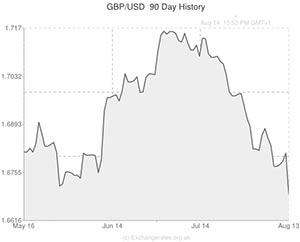
It was a bit of a grim day for economic news on Thursday and the Pound exchange rate continued to suffer significantly as a result against the majority of its major peers.
Against the US Dollar, the GBP to USD exchange rate was trading close to its lowest level since April as Wednesday’s comments by the Bank of England and overall weakness in the UK’s biggest trading partner of the Eurozone weighed heavily.
Weak wage growth data and the BoE announcing that it was in no hurry to raise interest rates saw investors embark a round of selling the Pound.
On Thursday, the currency was softened yet further when a member of the Central Bank’s Monetary Policy Committee, David Miles, said that the bank could keep rates unchanged at record-low levels for a bit longer and hinted that a rise will not occur until March 2015 at the earliest.
BoE Governor Mark Carney was not in economists’ good books after he was accused of being unpredictable. Earlier in the year, he suggested that interest rates could increase sooner than anyone expected, now he has changed his tune to one where rates are unlikely to occur until next year.
In June, a member of parliament hit the headlines when he compared the BoE governor to an “unreliable boyfriend” for blowing hot and cold over when interest rates might rise.
‘Sterling is clearly disappointed by Carney’s moving of the goalposts yet again,’ said a currency strategist from UBS.
Due to the uncertainty, regarding interest rates the Pound was unable to regain lost ground against the US Dollar.
The ‘Greenback’ would normally have softened following the release of disappointing jobless claims data but due to the current weakness in Sterling, it was able to hold onto recent gains.
The number of US citizens filing for unemployment benefits increased more than expected last week according to the Washington based Labour Department.
The number of people making new claims increased by 21,000 to 311,000, the highest number recorded in six weeks. The figure was more than the 295,000 figure forecast by economists. The number of American continuing to receive jobless benefits also increased by 25,000 to take the total number to 2.54 million in the week ending on August 2.
Against the Euro (EUR) the US Dollar weakened despite the release of data which showed that economic growth in the Eurozone stagnated in the second quarter.
Pound Sterling to US Dollar (GBP/USD) Exchange Rate Gains Moderately after UK GDP Growth
The extent of the negative sentiment towards Sterling, after the combination of a dovish inflation report and soft average weekly wages, has left the Pound struggling against all of its major peers. As a result yesterday saw ‘Cable’ (GBP/USD) plunge close to a four-month low.
However this morning has seen some positivity in terms of UK domestic data. The quarter-on-quarter UK Domestic Product (GDP) met with the forecast figure remaining at 0.8%. The year-on-year GDP saw an unexpected gain from 3.1% to 3.2%. Whilst this news is far from repairing the damage from the past few days, it has helped to strengthen the Pound to US Dollar exchange rate fractionally.
The slight boost was also due to US Continuing Claims and Initial Jobless Claims posting unwanted gains.
Expect ‘Cable’ movement later today with several US domestic data releases.
US Dollar (USD) Exchange Rates
[table width=”100%” colwidth=”50|50|50|50|50″ colalign=”left|left|left|left|left”]
Currency, ,Currency,Rate ,
US Dollar, ,Pound Sterling,0.5994 ,
,Pound Sterling,0.5994 ,
US Dollar, ,Euro,0.7464 ,
,Euro,0.7464 ,
US Dollar, ,Canadian Dollar,1.0902 ,
,Canadian Dollar,1.0902 ,
US Dollar, ,Australian Dollar,1.0735 ,
,Australian Dollar,1.0735 ,
Pound Sterling, ,US Dollar,1.6681 ,
,US Dollar,1.6681 ,
Euro, ,US Dollar,1.3398 ,
,US Dollar,1.3398 ,
[/table]

Comments are closed.